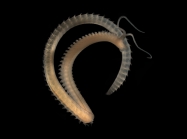RAS taxon details
Scolelepis Blainville, 1828
129623 (urn:lsid:marinespecies.org:taxname:129623)
accepted
Genus
Nerine Johnston, 1838 · unaccepted (subjective synonym)
- Subgenus Scolelepis (Scolelepis) Blainville, 1828
- Species Scolelepis eltaninae Blake, 1983 represented as Scolelepis (Scolelepis) eltaninae Blake, 1983
marine, brackish, fresh, terrestrial
recent only
Blainville, H. M. D de [Henri-Marie Ducrotay]. (1828). Mollusques, Vers et Zoophytes <b>[entries in VEA-VERS, volume 57]</b>. <em>In: Dictionnaire des Sciences naturelles, dans lequel on traite méthodiquement des différens êtres de la nature, considérés soit en eux-memês, d'après l'état actuel de nos connoissances, soit relativement à l'utilité qu'en peuvent retirer la médicine, l'agriculture, le commerce et les arts. Suive d'une biographie des plus célèbres naturalistes.</em> vol. 57 [Tome LVII. Vea - Vers] F.G. Levrault, Strasbourg & Paris., available online at https://biodiversitylibrary.org/page/25316522
page(s): 492-493 [details]
page(s): 492-493 [details]
Read, G.; Fauchald, K. (Ed.) (2021). World Polychaeta Database. Scolelepis Blainville, 1828. Accessed through: RAS (Eds.) (2021) Register of Antarctic Species at: http://ras.biodiversity.aq/aphia.php?p=taxdetails&id=129623 on 2025-09-12
RAS (Eds.) (2025). Register of Antarctic Species. Scolelepis Blainville, 1828. Accessed at: https://ras.biodiversity.aq/aphia.php?p=taxdetails&id=129623 on 2025-09-12
Date
action
by
original description
Blainville, H. M. D de [Henri-Marie Ducrotay]. (1828). Mollusques, Vers et Zoophytes <b>[entries in VEA-VERS, volume 57]</b>. <em>In: Dictionnaire des Sciences naturelles, dans lequel on traite méthodiquement des différens êtres de la nature, considérés soit en eux-memês, d'après l'état actuel de nos connoissances, soit relativement à l'utilité qu'en peuvent retirer la médicine, l'agriculture, le commerce et les arts. Suive d'une biographie des plus célèbres naturalistes.</em> vol. 57 [Tome LVII. Vea - Vers] F.G. Levrault, Strasbourg & Paris., available online at https://biodiversitylibrary.org/page/25316522
page(s): 492-493 [details]
original description (of Nerine Johnston, 1838) Johnston, George. (1838). Miscellanea Zoologica. III. — The British Ariciadae. <em>Magazine of Zoology and Botany, Edinburgh.</em> 2: 63-73, plates II-III., available online at https://biodiversitylibrary.org/page/40025966
page(s): 66, 68-70 [details]
additional source Fauchald, K. (1977). The polychaete worms, definitions and keys to the orders, families and genera. <em>Natural History Museum of Los Angeles County: Los Angeles, CA (USA), Science Series.</em> 28:1-188., available online at http://www.vliz.be/imisdocs/publications/123110.pdf [details]
additional source Bellan, G. (2001). Polychaeta, <i>in</i>: Costello, M.J. <i>et al.</i> (Ed.) (2001). European register of marine species: a check-list of the marine species in Europe and a bibliography of guides to their identification. <em>Collection Patrimoines Naturels.</em> 50: 214-231. (look up in IMIS) [details]
additional source Day, J. H. (1967). [Sedentaria] A monograph on the Polychaeta of Southern Africa. Part 2. Sedentaria. British Museum (Natural History), London. pp. 459–842., available online at http://www.biodiversitylibrary.org/bibliography/8596 [details]
additional source Glasby, Christopher J.; Read, Geoffrey B.; Lee, Kenneth E.; Blakemore, R.J.; Fraser, P.M.; Pinder, A.M.; Erséus, C.; Moser, W.E.; Burreson, E.M.; Govedich, F.R.; Davies, R.W.; Dawson, E.W. (2009). Phylum Annelida: bristleworms, earthworms, leeches. <em>[Book chapter].</em> Chapt 17, pp. 312-358. in: Gordon, D.P. (Ed.) (2009). New Zealand inventory of biodiversity: 1. Kingdom Animalia: Radiata, Lophotrochozoa, Deuterostomia. Canterbury University Press, Christchurch. [details] Available for editors
identification resource Zhou, J.; Ji, W.; Li, X. 2009. A new species of Scolelepis (Polychaeta: Spionidae) from sandy beaches in China, with a review of Chinese Scolelepis species. Zootaxa 2236: 37–49
page(s): 38; note: Key to species of China [details]
identification resource Delgado-Blas, Víctor Hugo. (2006). Partial revision of <i>Scolelepis</i> (Polychaeta : Spionidae) from the Grand Caribbean Region, with the description of two new species and a key to species recorded in the area. <em>Contributions to Zoology.</em> 75(1-2): 75-97., available online at http://dpc.uba.uva.nl/ctz/vol75/nr01/art03
page(s): 76; note: Key to Scolelepis from the Grand Caribbean Region [details] Available for editors
page(s): 492-493 [details]
original description (of Nerine Johnston, 1838) Johnston, George. (1838). Miscellanea Zoologica. III. — The British Ariciadae. <em>Magazine of Zoology and Botany, Edinburgh.</em> 2: 63-73, plates II-III., available online at https://biodiversitylibrary.org/page/40025966
page(s): 66, 68-70 [details]
additional source Fauchald, K. (1977). The polychaete worms, definitions and keys to the orders, families and genera. <em>Natural History Museum of Los Angeles County: Los Angeles, CA (USA), Science Series.</em> 28:1-188., available online at http://www.vliz.be/imisdocs/publications/123110.pdf [details]
additional source Bellan, G. (2001). Polychaeta, <i>in</i>: Costello, M.J. <i>et al.</i> (Ed.) (2001). European register of marine species: a check-list of the marine species in Europe and a bibliography of guides to their identification. <em>Collection Patrimoines Naturels.</em> 50: 214-231. (look up in IMIS) [details]
additional source Day, J. H. (1967). [Sedentaria] A monograph on the Polychaeta of Southern Africa. Part 2. Sedentaria. British Museum (Natural History), London. pp. 459–842., available online at http://www.biodiversitylibrary.org/bibliography/8596 [details]
additional source Glasby, Christopher J.; Read, Geoffrey B.; Lee, Kenneth E.; Blakemore, R.J.; Fraser, P.M.; Pinder, A.M.; Erséus, C.; Moser, W.E.; Burreson, E.M.; Govedich, F.R.; Davies, R.W.; Dawson, E.W. (2009). Phylum Annelida: bristleworms, earthworms, leeches. <em>[Book chapter].</em> Chapt 17, pp. 312-358. in: Gordon, D.P. (Ed.) (2009). New Zealand inventory of biodiversity: 1. Kingdom Animalia: Radiata, Lophotrochozoa, Deuterostomia. Canterbury University Press, Christchurch. [details] Available for editors
identification resource Zhou, J.; Ji, W.; Li, X. 2009. A new species of Scolelepis (Polychaeta: Spionidae) from sandy beaches in China, with a review of Chinese Scolelepis species. Zootaxa 2236: 37–49
page(s): 38; note: Key to species of China [details]
identification resource Delgado-Blas, Víctor Hugo. (2006). Partial revision of <i>Scolelepis</i> (Polychaeta : Spionidae) from the Grand Caribbean Region, with the description of two new species and a key to species recorded in the area. <em>Contributions to Zoology.</em> 75(1-2): 75-97., available online at http://dpc.uba.uva.nl/ctz/vol75/nr01/art03
page(s): 76; note: Key to Scolelepis from the Grand Caribbean Region [details] Available for editors
 Present
Present  Inaccurate
Inaccurate  Introduced: alien
Introduced: alien  Containing type locality
Containing type locality

